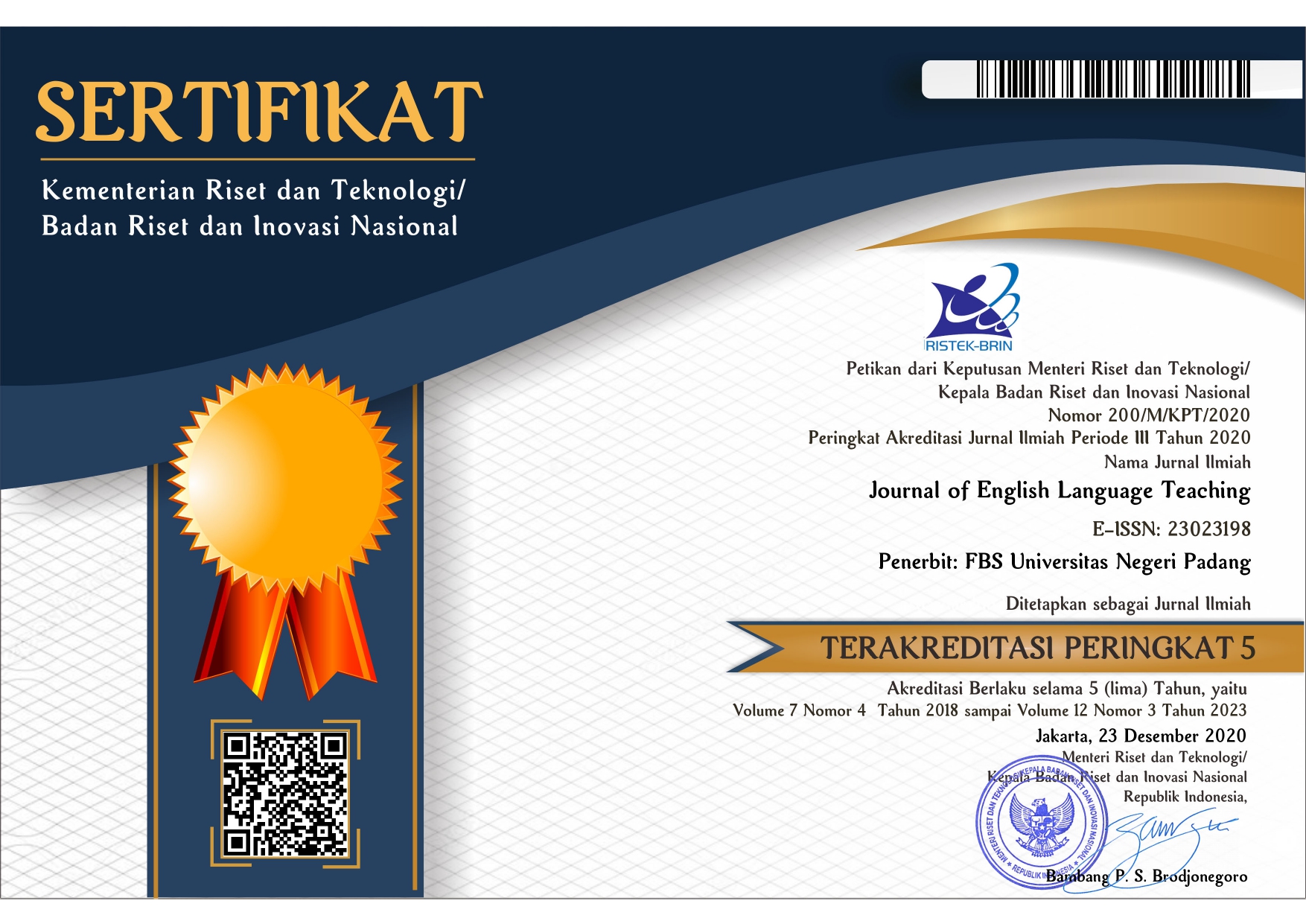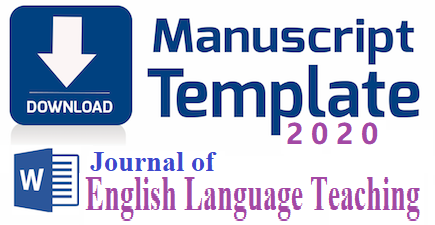Exploring Teacher Difficulties and Strategies in Teaching English at Islamic Boarding School of Nurmanisy Hikmatusallam
 ), Sitti Fatimah(2),
), Sitti Fatimah(2), (1) Universitas Negeri Padang
(2) Universitas Negeri Padang
 Corresponding Author
Corresponding Author
Copyright (c) 2024 Ogie Winas Saputra
DOI : https://doi.org/10.24036/jelt.v13i3.130834
Full Text:
 Language : en
Language : en
Abstract
Keywords
References
Abrar, M., Mukminin, A., Habibi, A., Asyrafi, F., &Marzulina, L. (2018)." If our English isn't a language, what is it?" Indonesian EFL Student Teachers' Challenges Speaking English. The Qualitative Report, 23(1), 129-145.
Ajibola, M. A. (2010). Confronting the challenges of teaching English language as a second language in Nigeria. Journal of the Nigeria English Studies Association (JNESA), 95-105.
Al-Khairi, M. (2015). Qualities of an Ideal English Language Teacher: A Gender-Based Investigation in a Saudi Context. Journal of Education and Practice, 6(15), 88-98.
Ansari, A. A. (2012). Teaching of English to Arab students: Problems and remedies. Educational Research 3(6), 519-524.
Baker, J &Westrup, H. (2000). The English language teacher’s handbook: How to teach large classes with few resources.London, England: British Library Cataloguing in Publication Data.
Borg, S. (2006). The distinctive characteristics of foreign language teachers. Language teaching research, 10(1), 3-31.
Bulter, Y. G. (2005). Comparative perspectives towards communicative activities among elementary school teachers in South Korea, Japan and Taiwan.Language Teaching Research, 423-446.
Burbules, N., &Harsen, D. (2018).Teaching and Its Predicaments. Routledge.
Burns, A., Morris-Adams, M., Garton, S., & Copland, F. (2013). Key factors and challenges in transition from primary to secondary schooling in ELT: An international perspective. Practical guidelines for working at transition levels.Birmington, Aston University: British Council.
Cahyati, P., &Madya, S. (2019, June). Teaching English in primary schools: Benefits and challenges.In 3rd International Conference on Current Issues in Education (ICCIE 2018) (pp. 395-400).Atlantis Press.
Copland, F., Garton, S., & Burns, A. (2014). Challenges in teaching English to young learners: Global perspectives and local realities. Tesol quarterly, 48(4), 738-762.
Creswell, J. W. (2012). Educational research.pearson.
Derakhshan, A., &Hasanabbasi, S. (2015). Social networks for language learning. Theory and Practice in Language Studies, 5(5), 1090.
Emery, H. (2012).A global study of primary English teachers’ qualifications, training and career development. ELT research papers, 12(08).
Fatiloro, O. F. (2015). Tackling the challenges of teaching English language as second language (ESL) in Nigeria. IOSR Journal of Research & Method in Education (IOSR-JRME), 26-30.
Gana, M., Haryanto, &Salija, K. (2018). Teachers’ Strategies in Teaching Speaking (a Case Study of an English Teacher in SmaNegeri 1 Toraja Utara). Teachers’ Strategies in Teaching Speaking, 1–10.
Garton, S., Copland, F., & Burns, A. (2011).Investigating global practices in teaching English for young learners: Project report. London, England: British Council.
Habibi, A., Mukminin, A., Najwan, J., Sofwan, M., Haswindy, S., Marzulina, L., Sirozi, M., &Harto, K. (2018). Investigating EFL Classroom management in pesantren: A case study. Qualitative Report, 23(9), 2105–2123. https://doi.org/10.46743/2160-3715/2018.3117
Hasan, L. N. K. (2016). The effect of lack of vocabulary on English language learners’ performance with reference to English departments students at Salahaddin University-Erbil. ØÄÙÇÑìÒÇäßÄ ÈÄ ÒÇäÓÊÉãÑÄÙÇíÉÊííÉßÇä (ZANCO Journal of Pure and Applied Sciences), 211-227.
Hashmi, M. A., Tahir, A., &Akhter, M. S. (2019). Pedagogical and learning challenges in implementing English as a medium of instruction in rural area public schools. Erevna: Journal of Linguistics and Literature, 3(2), 42-56.
Harmer, J. 2007. “The Practice of English Language Teaching: Fourth Edition”. China: Pearson Education Limited.Hayes, R. L., & Lin, H. (1994). Coming to America: Developing social support systems for international students. Journal of Multicultural Counseling and Development, 22,7–16. doi:10.1002/j.2161-1912.1994.tb00238.
Hidayati, R. (2018). The Implementation of Mimicry Memorization Method to Teach Vocabulary to English Club Student of DarulAmanah Islamic Boarding School Kendal in Academic Year 2017/2018 (Doctoral dissertation, IAIN SALATIGA).
Hoa, N., & Mai, P. (2016). Difficulties in teaching English for specific purposes: Empirical study at Vietnam universities. Higher Education Studies, 6(2), 154-161.
khan,T.J.,&khan,N. (2016). obstacles in learning english as a second language among intermediate students of districts Mianwali and Bhakkar,pakistan. open journal of social sciences,, 4,154,162.
Khan, I. (2011).Learning difficulties in English: Diagnosis and pedagogy in Saudi Arabia. Educational Research, 2 (7), 1248-1257.
Kholili, Y. (2021). Challenges for pesantren in the revolution era of society 5.0. AMCA Journal of Religion and Society, 1(1), 8-12.
Littlewood, W. (2007). Communicative andtaskbased language teaching in East Asian classrooms. Language Teaching, 243-259.
Mackey, A., &Gass, S. M. (Eds.). (2011). Research methods in second language acquisition: A practical guide (Vol. 7). John Wiley & Sons.
Marzulina, L., Harto, K., Erlina, D., Holandyah, M., Desvitasari, D., Arnilawati, A., ...&Mukminin, A. (2021). Challenges in teaching english for efl learners at pesantren: Teachers’ voices. Theory and Practice in Language Studies, 11(12), 1581-1589.
Maulidya, R. A., Atasyah, N. F., Husna, N., Hidayat, D. N., & Hamid, F. (2021).The implementation of communicative media for teaching English as a Foreign Language (EFL) during pandemic of Covid-19 in Indonesian senior high schools. Faktor: JurnalIlmiahKependidikan, 8(1), 73-92.
Miles, M. B., &Huberman, A. M. (1994). Qualitative data analysis: An expanded sourcebook. sage.
Muazza, M., Mukminin, A., Habibi, A., Hidayat, M., &Abidin, A. (2018). Education in Indonesian islamic boarding schools: Voices on curriculum and radicalism, teacher, and facilities. Islamic Quarterly, 62(4), 507-536.
Muhson, A. (2006). Teknikanalisiskuantitatif. UniversitasNegeri Yogyakarta. Yogyakarta, 183-196.
Moleong, J. (2009). Lexy. Metodologipenelitiankualitatif, 107-108.
Nunan, D. (2003). The impact of English as a global language on educational policies and practices in the Asia-Pacific region. TESOL Quarterly,, 589-613
Nurkamto, j. (2003).ProblemapengajaranbahasaInggris di Indonesia. . JurnalIlmiahMasyarakatLinguistik Indonesia 21(2), 288-307.
Pande, V. B. (2013). Problems and remedies in teaching English as a second language. Confluence, 416-421.
Sugiyono, D. (2013). Metodepenelitianpendidikanpendekatankuantitatif, kualitatifdan R&D.
Tang, E., Chung, E., Li, E., &Yeung, S. (2016). Online Independent Vocabulary Learning Experience of Hong Kong University Students. IAFOR Journal of Education, 4(1), 13-29.
Uyun, M., &Warsah, I. (2022).Prospective Teachers' Intercultural Sensitivity alongside the Contextual Factors as the Affective Domain to Realize Multicultural Education. International Journal of Instruction, 15(4).
Wajdi, F., &Aulia, R. N. (2019).Ma ‘had'Aly and the Challenge of Modernizing Islamic Education in Indonesia. Hayula: Indonesian Journal of Multidisciplinary Islamic Studies, 3(2), 173-190.
Yulia, Y. (2013). Teaching challenges in Indonesia: Motivating students and teachers’ classroom language. Indonesian Journal of Applied Linguistics, 3(1), 1-16.
Zulfikar, T. (2020). EFL Research: Designs and Thesis Wr
iting.
 Article Metrics
Article Metrics
 Abstract Views : 20 times
Abstract Views : 20 times
 PDF Downloaded : 8 times
PDF Downloaded : 8 times
Refbacks
- There are currently no refbacks.
Copyright (c) 2024 Ogie Winas Saputra

This work is licensed under a Creative Commons Attribution-NonCommercial 4.0 International License.
















